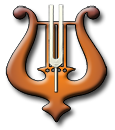01
Temperament
Temperament I’ve found trying to explain temperament to someone who knows nothing about piano tuning to be difficult. I’ll give it another try! Piano tuners need to start somewhere, so we use a tuning fork (usually A440 or C523) as a reference note. All we need is one note that we know is right, then we go from there.
02
Tuning the Bass
Tuning the Bass Bass bridges are by design, closer to the edge of the soundboard. Because it is on a less flexible area of the soundboard than the treble bridge, the bass section often reacts differently to changes in humidity than the rest of the piano. I often find that the bass section is less prone to the seasonal shifts of pitch than the treble.
03
Tuning the Treble
Tuning the TrebleTuning the top octave can be the most difficult to hear for many people. Whatever the size of the piano, the string length in the top octave is so short, the tone is always at its thinnest here. Less tone also makes the noise of the action mechanism more noticeable. This section is a reminder that a piano is technically a percussion instrument when you hear those tiny hammers pounding away at whatever tone they may produce.
04
Tuning Techniques & Tools
Tuning Techniques and Tools The idea of setting the tuning pins to be at rest and completely stable seemed an almost mythical task when I first started learning how to tune. I was told that explanations could take it only so far, that learning the feel and control necessary to set the pins was something that only could be learned from tuning over and over again. My teachers were not exaggerating. I wish there was a profound suggestion I could make that would instantly make it more attainable. Until then, I have a few suggestions using my own techniques for setting the pins.
05
Advice and Opinions
Advice and Opinions Having a lot of patience is essential for anyone interested in becoming a piano tuner. My father unknowingly gave me the virtue of patience by making me sit through all those organ concerts when I was younger. The ability to entertain yourself is very useful in tuning and life in general. Good tuners need the patience to keep tuning no matter how bored they get and not hurry to “just get it over with”. When the tuning is done and some of the checks are off, tuners need to have the patience to go back and fix the problems, no matter how close they thought they were to being finished.
06
References and Acknowledgements
References and Acknowledgements The PTG is one of the largest resources available for anyone interested in piano tuning and technology. They publish a monthly newsletter, hold monthly chapter meetings all over the country, and organize seminars and conventions. Online resources include a list of training programs, PTG members across the country, and many other piano industry links.
